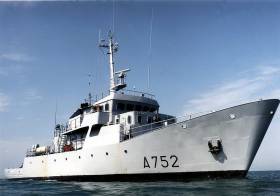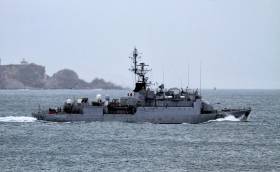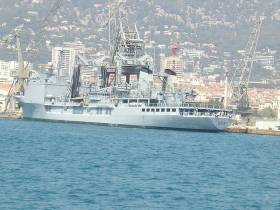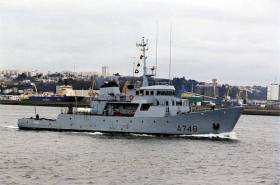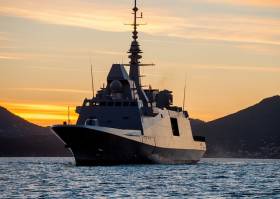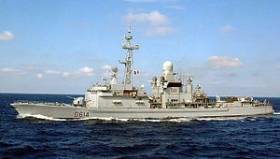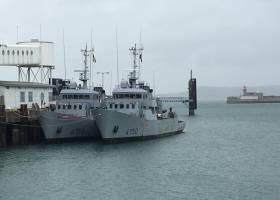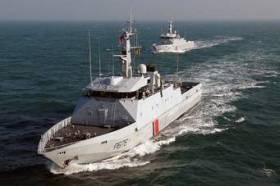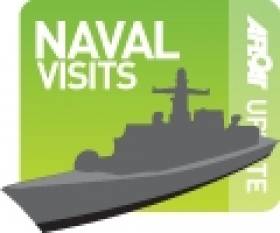Displaying items by tag: French Navy
French Navy Léopard Class Schoolships On Visit
#NavalVisits - A trio of French Navy trainee ships docked in Dublin Port for a crew rest and recreation visit to the capital this weekend, writes Jehan Ashmore.
The Léopard class school-training vessels each with 18 students, had arrived yesterday and berthed along Sir John Rogersons Quay.
Each of the small ships measure 43m in length and have a beam of 8.30m. The trio are the Lynx, Panthère and Tigre.
Displacing 335 tonnes, the sisters are part of an eight-strong class that were commissioned in the early 1980's. Among them Jaguar which along with Tigre called to Dun Laoghaire Harbour just over a year ago.
Arnament comprises of pair of 12.7mm guns.
The range of the Léopard class is 5,000 nautical based on a speed of 12 knots.
Winter Visitor From France Makes Call to Cork City Quays
#navalvisits - A French Navy frigate docked in Cork city at the weekend having sailed from Cherbourg, Normandy though the ship is based at Brest Naval Base in neighbouring Brittany, writes Jehan Ashmore.
The 1,250 tonnes full displacement Commandant L'Herminier (F 791) according to the Port of Cork website remains berthed this morning at the city-centre’s South Quays. A crew compliment totalling almost 90 personnel consists of 7 senior officer ranks, 58 secondary officer mariners and 24 cadets.
Commandant L'Herminier is an Aviso type A69 / d'Estienne d'Orves ship that was commissioned into the French Navy having made a debut more than three decades in 1986. The 80m long class vessel designed for anti-submarine duties also carries out high sea escort missions and various other tasks.
Among the principle weaponary of the class are Exocet sea missiles and the ability to launch torpedoes. In addition equipment such as a drone that form part of a suite of surveillance operations.
A maximum 15 day duration period is available when operating in an autonomous mode. The ship's service speed is 24 knots.
Flotilla From French Navy All to Arrive to Dublin Port This Friday
#FrenchFriday- A flotilla from the French Navy are all scheduled to have arrived to Dublin Port this Friday and in the capital the French embassy will on Saturday take part in 'Open House Dublin' this weekend, writes Jehan Ashmore.
Originally a quartet of French naval vessels were expected to call, however Afloat has monitored that this total has been reduced to three ships that are to visit. They are a minehunter, a frigate and an auxiliary oil/stores replenishment ship.
First to arrive at lunch hour today, will be the minehunter Sagittaire of the 'Eridan' class also otherwise known as the 'Tripartite' class. They are from a shared ship build programme that was co-ordinated with the combined co-operation of the French, Belgium and Dutch navies.
The 51m Sagittaire with a displacement of 615 tonnes is to arrive upriver along Sir John Rogersons Quay. This 21 year old vessel was completed by Direction des Constructions Navales (DCN) in Lorient, south Brittany.
The remaining pair are to arrive tomorrow, firstly in the form of the frigate Lieutenant de vaisseau Lavallée. This 80m vessel which is a 'Estienne d'Orves' class OPV frigate that among its principle weaponary consists of Exocet missiles. Likewise of the minehunter, the frigate will take a berth upriver on the Liffey along Sir John Rogersons Quay.
This leaves the final caller the 157m BCR Somme, the second of three 'Durance' class oil /stores supply sisters in which this particular ship entered service in 1990. The 18,000 full displacment tonnes ship is to dock within the deeper waters of Alexandra Basin. This is the largest basin within the port that is located close to the Tom Clarke bridge.
As previously reported here on Afloat, it is at the Tom Clarke bridge (seaward side) where the excursion boat St. Bridget will be operating (pre-booked) port tours (Saturday, 14 Oct) also as part of events during Open House Dublin. The tour is to take in Alexandra Basin where phase one of major redevelopment works has begun as part of the port masterplan.
#Flotilla – A French Navy flotilla all consisting of training vessels are visiting Dublin where also in port is the Finnish Navy’s flagship, writes Jehan Ashmore.
The small training ships that arrived yesterday belong to the Léopard class which were commissioned into service from 1982 and the following year. In fact almost all the class are in the capital given that five of the eight training ships are making the four-day call.
Leadship and class namesake, Léopard is visiting along with Chacal, Guépard, Tigre and Panthère. Each vessel is just 335 displacement tonnes and have a length of 43.0m on a beam of 8.30m. In addition to the training cadets, the class are used to carry out anti-pollution duties.
As for the Finnish Navy’s flagship, FNS Hämeenmaa, this is the first caller to the capital undertaken by the Nordic nation. The minelayer of 1,300 displacement tonnes had arrived on Wednesday direct from Funchal, Madeira.
Stealth Frigate Underway to Dublin for Call and Public Tours
#StealthShip - Presenting ‘stealth’ characteristics is frigate Provence of the French Navy which is to make a courtesy call to Dublin tomorrow and will be open at the weekend, writes Jehan Ashmore.
On Saturday the public are invited to board the slick 6,000 gross tonnage 'Aquitaine' class FREMM frigate. The visit will allow for a crew rest in the capital.
Measuring 142m long vessel, Provence is of the French Frégate européenne multi-mission (FREMM) programme in which the ship is the second of the class. The vessel was built in Brest by DCNS in 2015.
Provence is one of three active multiple-purpose frigates serving French Navy and they are equipped to operate during anti-submarine missions.
Among the equipment which is fitted with the latest technology includes MU90 torpedoes, variable depth sonar and bow mounted sonars.
At the stern is where a NH90 helicopter can be landed and this aircraft is fitted with buoys and flash sonar.
French Navy with 400 Crew Visit Dublin on Extended Shore Leave
#ExtendedVisit – Almost 400 visiting crew members from a pair of French Navy vessels that docked in Dublin Port as reported yesterday, will remain berthed in the capital on extended shore leave up to next Thursday, writes Jehan Ashmore.
The naval vessels are a destroyer and an auxiliary replenishment tanker and will not be open to public unlike the NATO flotilla that called to the capital earlier this month.
Normally such visits are confined over a weekend, but on this occasion the call to the capital involves an extended leave during the centenary of the 1916 Easter Rising that begins tomorrow.
The F70 AA or ‘Cassard’ Class leadship Cassard (D 614) one of two sisters, are guided-missile destroyers despite the French Navy that designate them as frigates. The 5,000 deadweight replacement tonnes destroyer has a crew of 230 and was joined yesterday lunchtime by ‘Durance’ class replenishment tanker Var (A 608) with a crew of 150.
The destroyer docked within Alexandra Basin located in the centre of the port while downriver at Ocean Pier is where the 18,000 tonnes displacement at full load tanker berthed.
Cassard was launched in 1985 and three years later was commissioned into service. The 139m long frigate has a top speed of 30 knots. Main armament consists of Mistral and Exocet missiles. A hanger is where Panther type helicopters provide additional capabilities for the Cassard class.
Replenishment auxiliary tanker Var was launched in Brest in 1981 and two years later entered service. The 157m long tanker can achieve a more modest 19 knots and has a range of defence equipment among them a pair of 20 mm Oerlikon guns.
Likewise of the destroyer, Var can handle a Panther helicopter along with a variety of other such aircraft, among the examples are the Dauphin, Cougar, Gazelle and Puma.
Another French Navy Double Act Bound for Dublin Bay
#FrenchDouble - Following earlier this month’s NATO flotilla to Dublin Port, a pair of French Naval vessels are to make an appearance albeit they will not be open to the public, writes Jehan Ashmore.
The F70 AA class frigate Cassard (D 614) along with an auxiliary replenishment tanker Var (A 608) are to arrive in Dublin Bay tomorrow. The former is due in Dublin Port in the morning while the later takes a lunchtime slot.
Unlike the NATO visitors which berthed near the East-Link bridge, the French visitors will be away from the public gaze. The frigate will be tucked away in the adjacent Alexandra Basin. As for the ‘Durance’ class tanker, this vessel will be berthed downriver at Ocean Pier.
At the same time of the NATO flotilla, Afloat reported that of the visit to Dun Laoghaire Harbour of another French Navy pair of the Leopard class cadet trainee vessels.
#FrenchNavy - A pair of French Navy trainee vessels visited Dun Laoghaire Harbour while all the attention focused on the NATO flotilla to neighbouring Dublin Port last weekend, writes Jehan Ashmore.
It was a busy scene as hundreds of visitors flocked to the NATO six-strong flotilla on the Liffey beside the East-Link Bridge. In stark contrast across the bay in Dun Laoghaire, French Navy vessels Tigre and Jaguar were berthed without the attention that a NATO call can draw, largely due to media coverage.
Senior French naval ratings were welcomed from the two Leopard class vessels at a reception held in the Harbour Lodge of the Dun Laoghaire Harbour Company.
Each of the 335 tonnes vessels docked at berth No. 3 along St. Micheal’s Pier where the ‘former’ ferry terminal is available to let as previously reported on Afloat.
At this berth is also located the harbour’s only suitable ferry berth linkspan (see photo). The facility is to the left of the naval vessels but cannot be seen in the above photo.
On the adjacent side of St. Michaels Pier, is berth No. 4, where a linkspan (now redundent) was custom-built to handle the specialist berthing requirements of the HSS Stena Explorer. The fast-ferry was withdrawn from the Holyhead route following Stena’s closure of the service in 2014.
Flamingo Flies French Tricolor In Advance of Patrick's Day
#FrenchNavy– PSP Flamant (P676) a French Navy fisheries and coastguard patrol vessel docked in Dublin Port in advance of celebrating tomorrow's St. Patrick’s Day, writes Jehan Ashmore.
The OPV54 or 'Cormoran' bird class Flamant flying the 'tricolor' (adopted during the French Revolution) departed her homeport of Cherbourg and docked in the Irish capital this morning. It took two days for the 22 knot capable vessel to reach Dublin Bay where the naval visitor was greeted by the Liffey, a port pilot cutter.
A crew of just 20 personnel including tree trainees sailed upriver to the city centre at Sir John Rogersons Quay. Further along the south quays is O’Connell Bridge to where tomorrow’s largest St. Patrick's festival parade is to cross the Liffey to much fanfare in this centenary year of the 1916 Rising.
Flamant is to remain in port till Saturday morning and return to waters where the vessel is principally tasked in patrolling and surveillance duties in the zone économique exclusive (ZEE).
The OPV built by Constructions Mécaniques de Normandie also located in Cherbourg is from where the vessel sets off on these ZEE patrols. This involves patrols extending to 200 nautical miles offshore into the Atlantic Ocean.
She is equipped with a RIB concealed in a dock well which is accessed from a stern-lifting door.
French Navy Command, Logistics Supply Ship 'Somme' Calls to Dublin Port
#CommandShip – A French Navy command and supply ship BCR Somme (A 631), one of a series of oil tankers serving the fleet, is currently on a visit to Dublin Port, writes Jehan Ashmore.
Somme belongs to the Naval Action Force (Fan), Organic command of surface ships of the navy and is under the operational command of the commander of the maritime area of the Atlantic.
Laid down in 1985 at the Naval Yard in Brest, Brittany, the Somme which has a displacement of 7,800 tons and 18,000 tons at full load, was commissioned five year later. She is primarily used to be deployed in serving naval forces away from their bases during overseas missions.
The provisioning of supplies carried out by Somme involves various fuels (oil, diesel and jet fuel) in addition to water, food, drugs and ammunition and alternative materials. Heavy loads ranging from food, munitions and materials are transferred by sea cable support or by helicopter.
She is sponsored by the city of Amiens since 1990 and that of the Somme department was made the following year. In more recent years, her homeport has been based in Brest.
A departure from Dublin Port is scheduled for Tuesday morning.


























